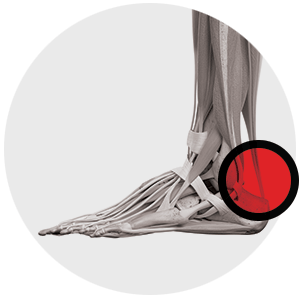Achilles Dysfunction

Achilles Tendon Dysfunction
There are many problems that can occur with the Achilles tendon. Tendonitis can be insertional where the tendon attaches to the bone or non-insertional. Acute rupture of the tendon can occur and that usually does involve operative intervention.
Insertional Tendonitis for what is known as Haglund’s Deformity
Inflammation of the Achilles tendon where it inserts into the calcaneus (heel bone) is known as insertional tendonitis. It is often associated with an abnormal bony prominence just deep to the tendon known as a Haglund’s deformity or “pump bump”. The insertion of the Achilles can then calcify, adding to the bump. This may play a role in rubbing on the deep aspect of the tendon to cause pain and inflammation in the soft tissues. It can then rub on footwear and even prevent the wearing of certain shoes.
Non-Operative Management
Non-operative management involves activity modification, rest, ice, stretching exercises, anti-inflammatories and a heel lift orthosis. A medial arch may be of assistance to decrease over-pronation that may exacerbate symptoms. Seeing your local physiotherapist is recommended for initial treatment. The use of oral analgesics is recommended as well. Corticosteroids are not recommended for this condition, however Dr Rao does perform platelet rich plasma injections under anaesthetic for this condition and this has been very successful in relieving pain.
Non-Insertional Tendonitis
Non-insertional tendonitis inflammation occur in and around the Achilles tendon higher up the leg from the heel. It often occurs with running and jumping sports. It can also occur with overuse syndrome, postural problems, poor footwear and underlying inflammatory conditions. The abnormal lump is felt higher up the leg in the Achilles tendon region.
Non-Operative Management
Non-operative management is similar to that on insertional tendonitis. If these non-operative measures do not work after 3-4 months, then surgery is indicated.
Acute Achilles Tendon Rupture
Rupture of the Achilles tendon may follow a prodromal phase of tendinosis. Often you may have experienced some pain in your Achilles tendon for a few weeks to months prior to it actually rupturing. The actual event that does cause the rupture is mechanical stress associated with rapid loading of the already tense tendons such as lunging forward from a standing start, unexpected stepping in a hole, jumping from a height. Whatever the cause, patient describe a sudden pain like being kicked in the back of the leg (or sometimes even shot in the back of the leg). They may also hear an audible pop.
Non-Operative Management
Non-operative management involves placing the leg in a boot with the foot plantar flexed (pointed down). The boot is then adjusted every 2 weeks until the ankle is finally neutral. This process takes approximately 8-10 weeks. However, there is a high association of re-rupture with this technique and it is often reserved for patients who are at high risk of complication from surgery or who elect not to have an operation after the pros and cons have been explained by Dr Rao.
Meet Dr Rao
Dr Rao is a Newcastle Orthopaedic surgeon who specialises in all aspects of foot and ankle surgery. He graduated from medicine at the University of Sydney and trained as an orthopaedic surgeon in Newcastle and also in Queensland.
He also undertook further training by way of fellowship with world famous Dr Terry Saxby in Brisbane in 2008. He has also conducted further training by attending numerous courses overseas, in Thailand, the USA and right across Australia.

